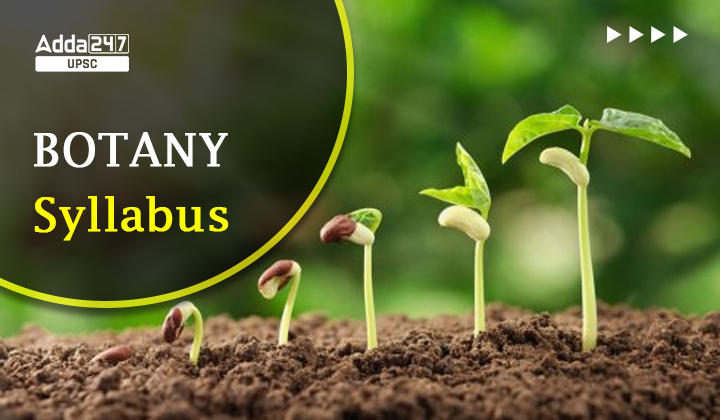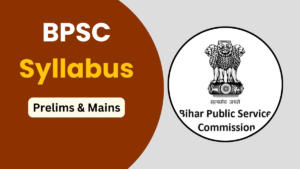Table of Contents
To prepare for the UPSC Botany Optional exam, it is important to understand the syllabus, plan strategically, and study consistently. The Botany syllabus for UPSC Mains includes topics like Plant Diversity, Plant Anatomy, Plant Physiology, Genetics, and Plant Breeding. The exam consists of two papers: Paper I and Paper II, which are part of the Mains stage of the IAS exam, which includes a total of 9 papers.
UPSC Botany Syllabus 2025 Highlights
The UPSC Botany Optional Syllabus is divided into two papers, each carrying 250 marks, resulting in a total of 500 marks. The UPSC Botany Optional Syllabus includes 11 main topics, each with several sub-topics. To cover the entire syllabus effectively, candidates should create a strategic study plan. This will help improve their chances of performing well and advancing to the next stage of the UPSC Exam. Check the table for the detailed UPSC Botany Syllabus 2025.
| UPSC Botany Syllabus 2025 Highlights | |
| Name of Conducting Body | UPSC |
| Mode Of Exam | Paper Pen based examination (offline mode) |
| Botany Optional Subject | Paper I & II |
| Total Questions | 5 (for both Paper) |
| Total Marks | 250 Marks for Each (Paper I & II) |
| Total Time | 3 Hours Each |
| Language of Question Paper | English and Hindi only |
| Official Website | upsc.gov.in |
UPSC Botany Syllabus 2025 for Mains
Before starting their preparation, candidates should thoroughly review the UPSC Botany Syllabus 2025. This will help aspirants understand important topics they need to focus on and the weightage given to each. The UPSC Botany Optional syllabus includes the following topics:
UPSC Botany Syllabus For Optional Paper 1
The first paper of the UPSC Botany Syllabus covers various topics including Microbiology and plant pathology, cryptogams, phanerogams, plant utility and exploitation, and morphogenesis. The complete syllabus for Paper I is provided in the table below for a detailed syllabus.
| UPSC Botany Syllabus for Mains (Paper 1) | |
| 1. Microbiology and Plant Pathology |
|
| 2. Cryptogams | Algae, Fungi, Bryophytes, Pteridophytes-structure and reproduction from an evolutionary viewpoint. Distribution of Cryptogams in India and their economic potential. |
| 3. Phanerogams |
|
| 4. Plant Utility and Exploitation | Origin of cultivated plants, Vavilov’s centres of origin. Plants as sources of food, fodder, fibers, spices, beverages, drugs, narcotics, insecticides, timber, gums, resins, and dyes. Latex, cellulose Starch, and their products. Perfumery. Importance of Ethnobotany in the Indian Context. Energy plantation. Botanical Gardens and Herbaria. |
| 5. Morphogenesis | Totipotency, polarity, symmetry, and differentiation. Cell, tissue, organ, and protoplast culture. Somatic hybrids and Cybrids. |
Download PDF: UPSC Botany Syllabus 2025
UPSC Botany Syllabus For Optional Paper 2
The UPSC Botany Syllabus for Paper II is categorized into six topics, each of which consists of several subtopics. The detailed list of subtopics for each topic is provided in the table below for a detailed syllabus.
| UPSC Botany Syllabus for Mains (Paper 2) | |
| 1. Cell Biology | Techniques of Cell Biology. Prokaryotic and eukaryotic cells -structural and ultrastructural details. Structure and function of extracellular matrix or ECM (cell wall) and membranes-cell adhesion, membrane transport, and vesicular transport. Structure and function of cell organelles (chloroplasts, mitochondria, ER, ribosomes, endosomes, lysosomes, peroxisomes, hydrogenosome). Nucleus, nucleolus, nuclear pore complex. Chromatin and nucleosome. Cell signaling and cell receptors. Signal transduction (G-1 proteins, etc.). Mitosis and meiosis; molecular basis of the cell cycle. Numerical and structural variations in chromosomes and their significance. Study of polytene, lampbrush, and B-chromosomes–structure, behaviour, and significance. |
| 2. Genetics, Molecular Biology, and Evolution: | Development of genetics, and gene versus allele concepts (Pseudoalleles). Quantitative genetics and multiple factors. Linkage and crossing over–methods of gene mapping including molecular maps (the idea of mapping function). Sex chromosomes and sexlinked inheritance, sex determination and molecular basis of sex differentiation. Mutation (biochemical and molecular basis). Cytoplasmic inheritance and cytoplasmic genes (including genetics of male sterility). Prions and prion hypothesis. Structure and synthesis of nucleic acids and proteins. Genetic code and regulation of gene expression. Multigene families. Organic evolution-evidences, mechanisms, and theories. Role of RNA in origin and evolution. |
| 3. Plant Breeding, Biotechnology and Biostatistics | Methods of plant breeding — introduction, selection, and hybridization (pedigree, backcross, mass selection, bulk method). Male sterility and heterosis breeding. Use of apomixis in plant breeding. Micropropagation and genetic engineering–methods of transfer of genes and transgenic crops; development and use of molecular markers in plant breeding. Standard deviation and coefficient of variation (CV). Tests of significance (Z-test, t-test, and chi-square Test). Probability and distributions (normal, binomial, and Poisson distributions). Correlation and regression. |
| 4. Physiology and Biochemistry | Water relations, Mineral nutrition, ion transport, mineral deficiencies. Photosynthesis–photochemical reactions, photophosphorylation, and carbon pathways including C pathway (photorespiration), C, C, and CAM pathways. Respiration (anaerobic and aerobic, including fermentation-electron transport chain and oxidative phosphorylation. Chemiosmotic theory and ATP synthesis. Nitrogen fixation and nitrogen metabolism. Enzymes, coenzymes, energy transfer, and energy conservation. Importance of secondary metabolites. Pigments as photoreceptors (plastidial pigments and phytochrome). Photoperiodism and flowering, vernalization, senescence. Growth substances-their chemical nature, role, and applications in agri-horticulture, growth indices, growth movements. Stress physiology (heat, water, salinity, metal). Fruit and seed physiology. Dormancy, storage, and germination of seed. Fruit ripening — its molecular basis and manipulation. |
| 5. Ecology and Plant Geography | Ecological factors. Concepts and dynamics of the community. Plant succession. Concepts of the biosphere. Ecosystems and their conservation. Pollution and its control (including phytoremediation). |
| 6. Forest types of India | Afforestation, deforestation, and social forestry. Endangered plants, endemism, and Red Data Books.Biodiversity. Convention of Biological Diversity, Sovereign Rights and Intellectual Property Rights. Biogeochemical cycles. Global warming |
UPSC Botany Exam Pattern 2025
Each paper in the UPSC Botany Syllabus is of 250 marks, totaling 500 marks. Scoring well in these papers is key to improving overall performance in the UPSC Exam. Candidates with a background in Botany may find the syllabus relevant. It consists of two papers (Paper 1 and Paper 2), each lasting 3 hours.
| UPSC Botany Exam Pattern 2025 |
||
| Topic | Marks | Duration |
| UPSC Botany Optional Syllabus Paper 1 | 250 | 3 Hours |
| UPSC Botany Optional Syllabus Paper 2 | 250 | |
UPSC Botany Preparation Strategy 2025
- Gain a comprehensive understanding of the entire UPSC Botany Syllabus. Focus on charts and diagrams in Paper 1, while giving importance to cellular science and the atomic viewpoint in Paper 2.
- Develop a well-structured study plan and diligently follow it. This will ensure timely coverage of the UPSC Botany Optional Syllabus.
- Practice extensively, attempt UPSC mock tests, and review previous year’s questions to identify crucial topics that should be covered from the Botany syllabus.
- Select the best reference books available and execute your study plans effectively to maximize your preparation efforts.
Botany Reference Books
The following books are recommended by our mentors.
- Cell biology – De Robertis & Ambrose and Easy or Powar
- Botany for Degree Students; Pteridophyta (Vascular Cryptogams)-P.C. Vashishta.
- Ecology, Microbiology, Animal Behaviour, Pollution and Toxicology For B. Sc. Part III, Paper III- Dr Veer Bala Rastogi
- Economic botany in the tropics- S. L. Kochhar
- Embryology Of Angiosperms- S P Bhatnagar
- Genetics- Strickberger
- Elements of Genetics-Dr. Veer Bala Rastogi
- Plant Anatomy- B.P. Pandey
- Plant Anatomy- Esau
- Physiology and Biochemistry -Salisbury and Ross or Fritz and Noggle
- Systematic Botany-S C Datta
- Taxonomy-R Nair
- Microbiology- Powars
- Pathology- Singh’s book along with a foreign author
- Physiology and Biochemistry -Salisbury and Ross or Fritz and Noggle.
| Related Articles | |
| UPSC mains syllabus | UPSC Anthro syllabus |
| UPSC Economics syllabus | UPSC philosophy syllabus |
| UPSC History Syllabus | UPSC Zoology syllabus |
| UPSC Geography syllabus | UPSC English syllabus |



 APSC Syllabus 2025, Download Prelims And...
APSC Syllabus 2025, Download Prelims And...
 Punjab PCS Syllabus 2025, New Prelims an...
Punjab PCS Syllabus 2025, New Prelims an...
 BPSC Syllabus 2025 and Exam Pattern For ...
BPSC Syllabus 2025 and Exam Pattern For ...




